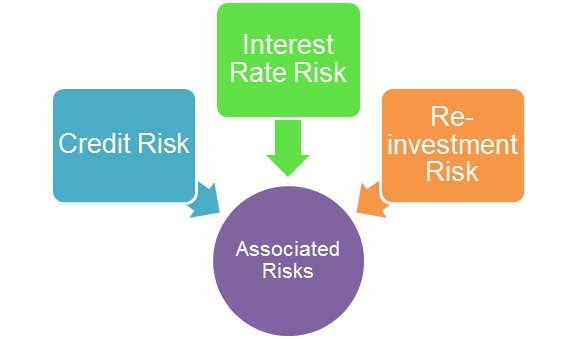Dont wan't to watch the video, read the text instead.
While investing in an Equity Mutual Fund, an investor thoroughly evaluates the fund attributes and portfolio construct. However, when it comes to Debt Mutual Fund the same approach is not followed as investors are not well versed with the different aspects of Debt Mutual Funds. It is important to understand these aspects before investing in a Debt Mutual Fund.
1. Risk Element:
Contrary to popular belief that Debt Mutual Funds are risk free investment avenue; they actually have following inherent risks:

Credit Risk:
It is the risk of loss of principal or any other cash flow due to borrower’s inability to meet his financial obligations.
Interest Rate Risk:
Fluctuation in interest rates affect the price of the bond; as interest rate rises, bond prices fall and vice versa.
Re-investment Risk:
Risk that the future coupon from a bond may not be re-invested at the prevailing interest rate when the bond was initially purchased.
2. Asset Allocation:
A scheme’s portfolio lays down the instruments where the scheme has invested in viz. Government securities (g-secs), commercial papers (CPs), certificate of deposits (CDs) etc. Depending on fund’s investment objective and fund manager’s view about the interest rate movement, the scheme’s asset allocation is decided. For e.g. If the Fund manager is expecting interest rate to fall, he might increase allocation to g-secs. While in scenarios of interest rate rise, the fund manger may increase allocation to shorter term instruments like commercial papers etc. Thus, the fund manager may tactically alter the asset allocation to combat interest rate risk.
3. Rating Allocation:
Credit risk of a scheme can be deduced by the credit rating of instruments where the scheme has invested in. Following is the generalised definition of ratings and indicative level of safety:
| Ratings for Long Term Instruments | Level of Safety |
|---|---|
| Sovereign | Investment in G-sec. High degree of safety |
| AAA | Highest Safety |
| AA | High Safety |
| A | Adequate Safety |
| BBB | Moderate Safety |
| BB | Moderate Risk |
| B | High Risk |
| C | Very High Risk |
| D | Default |
| Ratings for Short Term Instruments | Level of Safety |
|---|---|
| A1 | Very strong degree of safety |
| A2 | Strong degree of safety |
| A3 | Moderate degree of safety |
| A4 | Minimal degree of safety |
| D | Default or expected to default |
4. Maturity Profile/Average Maturity:
Maturity profile represents the maturity of all holdings in the fund’s portfolio. Average maturity is average maturity in days or years of all instruments held in the portfolio. Money market or short term funds might allocate majority of their corpus in short term papers; hence, they will have low average maturity.
5. Modified Duration:
Bond prices are inversely related to interest rates. Thus when interest rate rise, bond prices fall and vice versa. Modified duration measures the price sensitivity to the change in interest rates. For e.g. If the Modified duration of a Debt Scheme is 3 years and if interest rate falls by 1%, the NAV of Debt scheme is likely to go up by 3%. So if the fund manager is expecting that interest rates are likely to go down in future, he is likely to increase the modified duration of the scheme.
6. Yield to Maturity (YTM):
It is the total return anticipated on a bond if the bond is held till maturity.



